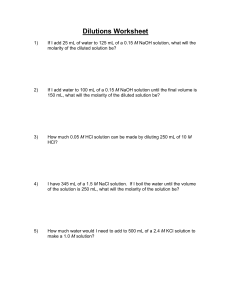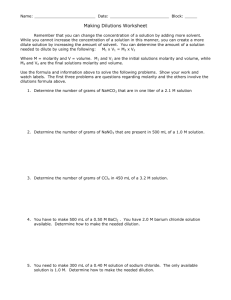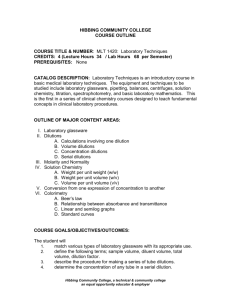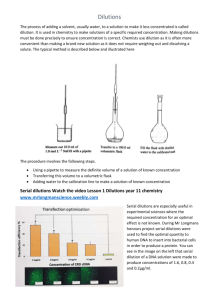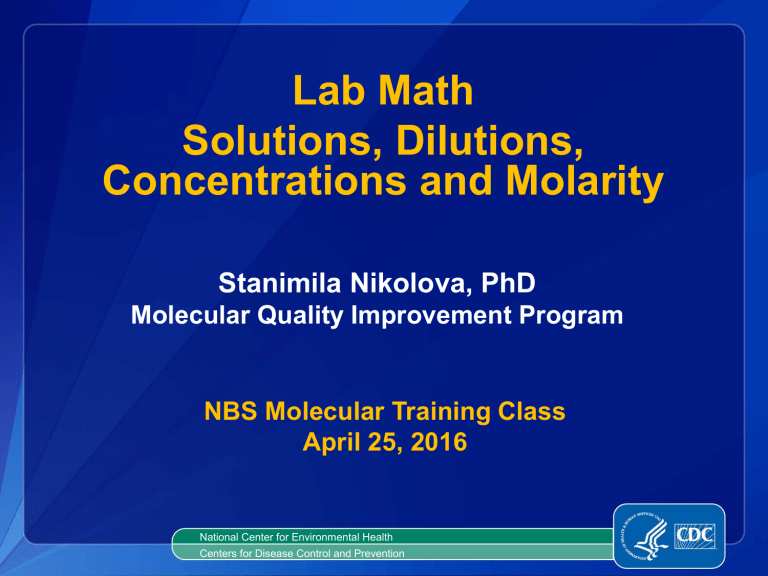
Lab Math Solutions, Dilutions, Concentrations and Molarity Stanimila Nikolova, PhD Molecular Quality Improvement Program NBS Molecular Training Class April 25, 2016 National Center for Environmental Health Centers for Disease Control and Prevention Lets Talk About Solutions Solution - a homogeneous mixture of two or more substances. Solute - a substance in a solution that is present in the smallest amount. Solvent - a substance in a solution that is present in the largest amount. Solubility - ability of the solute to dissolve in the solvent. Solutions & Dilutions Preparing solutions and making dilutions Simple dilutions Mixing parts or volumes Serial dilutions Making fixed volumes of specific concentrations from liquid reagents: (C1)(V1)=(C2)(V2) Percent solutions (= parts per hundred) Molar solutions (unit=M=moles/L) Solutions & Dilutions Preparing solutions and making dilutions Simple dilutions Mixing parts or volumes Serial dilutions Making fixed volumes of specific concentrations from liquid reagents: (C1)(V1)=(C2)(V2) Percent solutions (= parts per hundred) Molar solutions (unit=M=moles/L) A simple dilution is one in which a unit volume of material of interest (solute) is combined with an appropriate volume of a solvent to achieve the desired concentration The dilution factor is the total number of unit volumes in which your material will be dissolved. http://biology.kenyon.edu/courses/biol09/tetrahymena/serialdilution3.htm Solutions & Dilutions Preparing solutions and making dilutions Simple dilutions Mixing parts or volumes Serial dilutions Making fixed volumes of specific concentrations from liquid reagents: (C1)(V1)=(C2)(V2) Percent solutions (= parts per hundred) Molar solutions (unit=M=moles/L) Mixing parts or volumes ≠ simple dilutions Example: To make up a 1:3 acetic ethanol solution, you are supposed to mix one unit volume of acetic acid and three unit volumes of ethanol. However, to make 1:3 dilution of acetic acid in ethanol, you would mix one unit volume of acetic acid with two unit volumes of ethanol. Confused? “dilution” “dilute” Solutions & Dilutions Preparing solutions and making dilutions Simple dilutions Mixing parts or volumes Serial dilutions Making fixed volumes of specific concentrations from liquid reagents: (C1)(V1)=(C2)(V2) Percent solutions (= parts per hundred) Molar solutions (unit=M=moles/L) A serial dilution is a series of simple dilutions which amplifies the dilution factor quickly. The source of dilution material for each step comes from the diluted material of the previous. http://biology.kenyon.edu/courses/biol09/tetrahymena/serialdilution3.htm Solutions & Dilutions Preparing solutions and making dilutions Simple dilutions Mixing parts or volumes Serial dilutions Making fixed volumes of specific concentrations from liquid reagents: (C1)(V1)=(C2)(V2) Percent solutions (= parts per hundred) Molar solutions (unit=M=moles/L) Making fixed volumes of specific concentrations from liquid reagents: (C1)(V1)=(C2)(V2) C1V1 -source solution attributes; C= concentration* ; C2V2 -new solution attributes V= volume* *In whatever units you are working Example: Experiment requires a final concentration of 0.1 M Tris, in a total volume of 2ml vials. You have 1M soln. How much stock solution you will need? (C1)(V1)=(C2)(V2) (1 M) x V1= (0.1 M) x (2 ml) V1= (0.1 M) x (2 ml) / (1M) = 0.2ml Solutions & Dilutions Preparing solutions and making dilutions Simple dilutions Mixing parts or volumes Serial dilutions Making fixed volumes of specific concentrations from liquid reagents: (C1)(V1)=(C2)(V2) Percent solutions (= parts per hundred) Molar solutions (unit=M=moles/L) Percent solutions (= parts per hundred) Example: A 10% NaCl sol is equal to 10gNaCl in 100ml of solvent, because the solid is measured based upon weight (w) while solvent is measured based upon volume, the NaCl solution should be labeled as 10% w/v NaCl http://www.chemteam.info/Solutions/Molarity.html Solutions & Dilutions Preparing solutions and making dilutions Simple dilutions Mixing parts or volumes Serial dilutions Making fixed volumes of specific concentrations from liquid reagents: (C1)(V1)=(C2)(V2) Percent solutions (= parts per hundred) Molar solutions (unit=M=moles/L) Molarity (M) Is a concentration term for solution is the number of moles of solute dissolved in one liter of solution. To calculate the molarity of a solution, divide the moles of solute by the volume of the solution. http://www.chemteam.info/Solutions/Molarity.html Vocabulary to know Avogadro’s Constant: The number of objects in a mole: 6.02 x 1023 Mole: amount of a substance that contains 6.02 x 1023 particles. A mole of any pure substance has a mass in grams exactly equal to that substance’s atomic or molecular mass Molarity: A unit of concentration equal to the number moles of solute in a 1L of solution. A mole of any pure substance has a mass in grams exactly equal to that substance’s atomic or molecular mass (mass of one mole of a substance). MM of CO2 = 12C+ 1602 = 48g/mole (6.02x1023 molecules of CO2= 48g) Molarity dilutions: 1M solution of NaCl (23Na 35Cl) = 58 g NaCl dissolved in 1 liter of H2O 1mM (miliM) = 1:1000 dilution of 1M or 10-3 1μM (microM) = 1:1000 dilution of 1mM or 1:1,000,000 of 1M or 10-6 1nM (nanoM)= 1:1000 dilution of 1 μM or 1:1,000,000,000 of 1M or 10-9 1pM (picoM) = 1:1000 dilution of 1 nM or 1:1,000,000,000,000 of 1M or 10-12 What’s the μM concentration of a 1:10000 dilution of a solution containing 87 g of NaCl per litter? 1M NaCl = 58 g/L => ?M 1M = 87g/L 58g/L => ?M x 58g/L = 1.5M 1M x 87g/L 1:10000 dilution of 1.5M = 0.00015 M x 1000 mM = 0.15 mM = 150 μM Slide from Dr. Carlos Saavedra- NY State NBS What is the molarity when 0.75 mol is dissolved in 2.5L of solution? 0.75 mol moles of solute Molarity (M) = = = liters of soln 2. 50L 0.300M Calculate the molarity of 25g KBr dissolved in 750ml. MM of KBr = (39.1K+79.9Br) = 119 g/mol 25g = 0.210 mol 119 g/mol => 0.210 mol = 0.280M 0.75 L What is the molarity of 500ml NaOH sol, if it contains 6g NaOH? Step 1: Given 6g NaOH on 0.500L sol, Need molarity (M) Step 2: Conversion factors MM of NaOH = (23Na+16O+1H) = 40g/mol Step 3: Calculate molarity 6g 40 g/mol = 0.150 mol => 0.150 mol = 0.300M NaOH 0. 500L How many grams of KCl are needed to prepare 125mL of a 0.720 M KCl solution? Step 1: Given 125ml (0.125L) of 0.720M KCl, Need grams of KCl Step 2: Conversion factors MM of KCl = (39.1K+ 35.5Cl)= 74.6 g/mol Step 3: Calculate molarity 125 ml X 1L 1000 ml X M= mol L 0.720M KCl 1L X 74.6 g KCl 1M = 6.71 g KCl In conclusion: What is the molarity of “X” grams of your favorite substance dissolved in “X” mL of solution? To solve it, you convert grams to moles, then divide by the volume, like this: grams = moles molar mass moles volume = molarity GOLDEN RULE: ALWAYS TO CHECK UNITS!!! www.tailormadepensions.eu Thank you! The findings and conclusions in this presentation are those of the author and do not necessarily represent the views of the Centers for Disease Control and Prevention. For more information please contact Centers for Disease Control and Prevention 1600 Clifton Road NE, Atlanta, GA 30333 Telephone, 1-800-CDC-INFO (232-4636)/TTY: 1-888-232-6348 E-mail: cdcinfo@cdc.gov Web: www.cdc.gov The findings and conclusions in this report are those of the authors and do not necessarily represent the official position of the Centers for Disease Control and Prevention. National Center for Environmental Health U.S. Centers for Disease Control and Prevention
